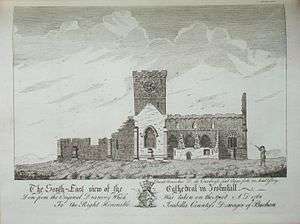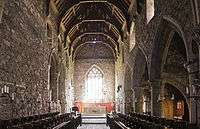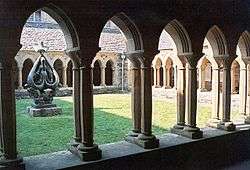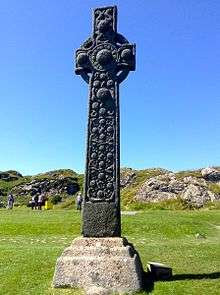Iona Abbey


Iona Abbey is located on the Isle of Iona, just off the Isle of Mull on the West Coast of Scotland. It is one of the oldest and most important religious centres in Western Europe. The abbey was a focal point for the spread of Christianity throughout Scotland and marks the foundation of a monastic community by St. Columba, when Iona was part of the Kingdom of Dál Riata. Iona Abbey is home to the Iona Community, an ecumenical Christian religious order, and remains a popular site of Christian pilgrimage today.[1]
History
Early history


In 563, Columba came to Iona from Ireland with twelve companions, and founded a monastery. It developed as an influential centre for the spread of Christianity among the Picts and Scots. The Book of Kells, a famous illuminated manuscript, is believed to have been produced by the monks of Iona in the years leading up to 800.[2] The Chronicle of Ireland was also produced at Iona until about 740. The abbey was first attacked by Viking raiders in 795, with subsequent attacks taking place in 802, 806, and 825.[3] During the 806 Viking attack, 68 monks were massacred in Martyrs' Bay, and this led to many of the Columban monks relocating to the Columban Abbey of Kells in Ireland. Other monks from Iona fled to the Continent, and established monasteries in Belgium, France, and Switzerland.[4] In 825, St Blathmac and those monks who remained with him at Iona, were martyred in a Viking raid, and the Abbey was burned. However, it was probably not deserted as its continued importance is shown by the death there in 980 of Amlaíb Cuarán, a retired King of Dublin.
Benedictine abbey
Iona had been seized by the King of Norway, who held it for fifty years before Somerled recaptured it, and invited renewed Irish involvement in 1164: this led to the construction of the central part of the Cathedral. Ranald, Somerled's son, now 'Lord of the Isles', in 1203 invited the Benedictine order to establish a new Monastery, and an Augustinian Nunnery, on the Columban Monastery's foundations. Building work began on the new Abbey church, on the site of Columba's original church.[5] The following year, in 1204, the site was raided by a force led by two Irish bishops. This was a response by Ireland's Columban clergy to the loss of its connections and influence at this significant site founded by St Columba.[6]
The Iona Nunnery, a foundation of the Augustinian Order (one of only two in Scotland - the other is in Perth), was established south of the Abbey buildings. Graves of some of the early nuns remain, including that of a remarkable Prioress, Anna Maclean, who died in 1543. Clearly visible under her outer robe is the rochet, a pleated surplice denoting the Augustinian Order. The Nunnery buildings were rebuilt in the fifteenth century and fell into disrepair after the Reformation.
The Abbey church was substantially expanded in the fifteenth century,[5] but following the Scottish Reformation, Iona along with numerous other abbeys throughout the British Isles were dismantled, and abandoned, their monks and Libraries dispersed.
Modern abbey

In 1899 the Duke of Argyll transferred ownership of the ruined remains of the Abbey and Nunnery sites to the Iona Cathedral Trust, which undertook extensive restoration of the Abbey church. In 1938, the inspiration of Reverend George MacLeod led a group which rebuilt the abbey, and founded the Iona Community. The reconstruction was organised by the architect Ian Gordon Lindsay having generously been passed the project from his senior mentor and friend Reginald Fairlie.[7] The surrounding buildings were also re-constructed during the 20th century by the Iona Community. This ecumenical Christian community continues to use the site to this day.
The simple square font was added in 1908 and dedicated to the memory of the Very Rev Theodore Marshall DD, Moderator of the General Assembly of the Church of Scotland in that year.[8]
In 2000 the Iona Cathedral Trust handed over the care of the Abbey, Nunnery, and associated sites to Historic Scotland.[9]
List of abbots
Items of Interest
Many early Scottish kings (said to be 48 in total), as well as kings from Ireland, Norway and France, are said to be buried in the Abbey graveyard. However, modern scholars are sceptical of such claims,[10] which were likely mythic associated with increasing the prestige of Iona. Numerous leading Hebrideans, such as various Lords of the Isles and other prominent members of West Highland clans, were buried on Iona,[11] including several early MacLeod chiefs.[12] The site was much loved by John Smith, 20th-century leader of the Labour Party, who was buried on Iona after his sudden death in 1994.[13]
 |
 |
| St. John's Cross in the Abbey museum. | St. Martin's Cross outside the abbey. |
Several high crosses are found on the Isle of Iona. St Martin's Cross (dated to the 8th century) still stands by the roadside. A replica of St John's Cross is found by the doorway of the Abbey. The restored original is located in the Infirmary Museum at the rear of the abbey.
The contemporary Jedburgh-based sculptor Christopher Hall worked for many years on carvings on the cloisters of the abbey, which represent birds, flora and fauna native to the island. He also was commissioned to carve John Smith's gravestone.
See also
- Abbot of Iona, for a list of abbots
- Inchcolm Abbey, so-called "Iona of the east"
- Dunkeld Cathedral, chief centre of the Columban cult in later medieval Scotland
References
- ↑ Holly Hayes (2005). "Iona Abbey - Iona, Scotland". Sacred Destinations.
Iona Abbey was the home of St. Columba, whose missionary work in the 6th century brought Celtic Christianity to Scotland. Now home to the ecumenical Iona Community, it remains a place of Christian pilgrimage.
- ↑ Dodwell, Charles Reginald (1993). The Pictorial Arts of the West, 800-1200. New Haven: Yale University Press. p. 84. ISBN 0-300-06493-4.
- ↑ Yeoman, Peter (2014). Iona Abbey and Nunnery, p. 61. Historic Scotland, Edinburgh. ISBN 978-1-84917-170-0
- ↑ Charles-Edwards, T.M. (2006). The Chronicle of Ireland. Liverpool University Press. ISBN 0-85323-959-2.
- 1 2 Information boards at Iona Abbey. Historic Scotland
- ↑ Yeoman, Peter (2014). Iona Abbey and Nunnery, p. 64. Historic Scotland, Edinburgh. ISBN 978-1-84917-170-0
- ↑ National Dictionary of Scottish Architects:Reginald Fairlie.
- ↑ http://www.waymarking.com/waymarks/WMHZDG_Baptismal_Font_StColumbas_Abbey_Church_Iona_Argyll_Bute_Scotland
- ↑ Yeoman, Peter (2014). Iona Abbey and Nunnery, p. 69. Historic Scotland, Edinburgh. ISBN 978-1-84917-170-0
- ↑ Fraser, JE. "Alexander I, Dunfermline and the Mausoleum of the Gaelic Kings of Scotland in Iona". Archived from the original (DOC) on 17 October 2012. Retrieved 13 September 2015 – via University of Aberdeen.
- ↑ McDonald, R. Andrew (1997), The Kingdom of the Isles: Scotland's Western Seaboard, c.1100–c.1336, Scottish Historical Monograph series #4, Tuckwell Press, p. 206 fn 17, ISBN 1-898410-85-2,
- ↑ MacLeod, Roderick Charles (1927), The MacLeods of Dunvegan, Edinburgh: Clan MacLeod Society, p. 30
- ↑ "Biography of John Smith". University of Glasgow. Retrieved 2008-06-17.
External links
| Wikimedia Commons has media related to Iona Abbey. |
- Iona Abbey – site information from Historic Environment Scotland
- Iona Community
- Iona Abbey website
- School of Iona Catholic Encyclopedia article
Coordinates: 56°20′03″N 06°23′37″W / 56.33417°N 6.39361°W